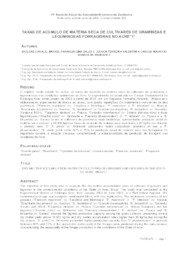Taxas de acúmulo de matéria seca de cultivares de gramíneas e leguminosas forrageiras no Acre.
Taxas de acúmulo de matéria seca de cultivares de gramíneas e leguminosas forrageiras no Acre.
Author(s): CAVALI, J.; SALES, M. F. L.; VALENTIM, J. F.; ANDRADE, C. M. S. de
Summary: O objetivo deste estudo foi avaliar as taxas de acúmulo de matéria seca de cultivares de gramíneas e leguminosas nas condições ambientais do Acre. O experimento foi conduzido no Campo Experimental da Embrapa Acre, entre janeiro de 2002 e junho de 2003, em um Argissolo Vermelho-Amarelo. Utilizou-se o delineamento experimental de blocos ao acaso, com quatro repetições. Os tratamentos consistiram de dez gramíneas ("Panicum maximum" cv. Tanzânia e Mombaça, "P. maximum" x "P. infestum" cv. Massai, "Brachiaria decumbens" x cv. Basilik, "B. humidicola" cv. Quicuio-da-amazônia, "B. brizantha" cv. Marandu, Xarés e MG-4, "Paspalum atratum" cv. Pojuca, "Cynodon nlemfuensis" cv. Estrela africana roxa) e duas leguminosas ("Arachis pintoi" cv. Belmonte e "Pueraria phaseoloides"). O "P. atratum" cv. Pojuca e a "B. brizantha" cv. Xaraés foram as cultivares de gramíneas mais productivas, apresentando produção anual de matéria seca superior a 18.500 kg/ha e taxas de acúmulo de matéria seca superiores a 30kg/ha.dia. , durante o período seco. O "A. pintoi" cv. Belmonte apresentou maior capaciddade produtiva do que a "P. phaseoloides". De modo geral, entre 60% e 70% da produção anual da matéria secadas forrageiras foi registrada durante a estação chuvosa, caracterizando a estacionalidade de produção de forragem nas condições do Acre. The objective of this study was to evaluate the dry matter accumulation rates of cultivars of grasses and legumes in the environmental conditions of the State of Acre, Brazil. The study was conduced at the Experimental Station of Embrapa Acre, from January 2002 to June 2003, in a Red-Yellow Argissol. The experiemntal design was complete randomized block, with four replications. The treatments consisted of ten grasses ("Panicum maximum" cv. Tanzânia e Mombaça, "P. maximum" x "P. infestum" cv. Massai, "Brachiaria decumbens" x cv. Basilik, "B. humidicola" cv. Quicuio-da-amazônia, "B. brizantha" cv. Marandu, Xarés e MG-4, "Paspalum atratum" cv. Pojuca, "Cynodon nlemfuensis" cv. Estrela africana roxa) and two lwgumes ("Arachis pintoi" cv. Belmonte e "Pueraria phaseoloides"). "P. atratum" cv. Pojuca and "B. brizantha" cv. Xaraés showed the highest productive capacity among the grass cultivars, presenting annual dry matter yield above 18.500 kg/ha and dry matter accumulation rates higher then 30 kg/ha.day. during the dry season. "A. pintoi" cv. Belmonte presented higher productive capacity than "P. phaseoloides". In general, between 60% and 70% of the annual dry matter yield of the forages were produced during the rainy season, characterizing the seasonality of the forage production in the conditions pf the State of Acre.
Publication year: 2004
Types of publication: Paper in annals and proceedings
Unit: Embrapa Acre
Keywords: Acclimation, Aclimatación, Aclimatação, Acre, Acumulación de materia seca, Amazonia Occidental, Amazônia Ocidental, Campo Experimental, Comportamento de Variedade, Condição Ambiental, Demonstration farms, Dry matter accumulation, Embrapa Acre, Ensayos de variedades, Environmental factors, Factores ambientales, Forage grasses, Forage legumes, Gramínea Forrageira, Granjas de demostración, Leguminosa Forrageira, Leguminosas forrajeras, Matéria Seca, Pastos forrajeros, Rio Branco (AC), Variety trials, Western Amazon
Observation
Some of Embrapa's publications are published as ePub files. To read them, use or download one of the following free software options to your computer or mobile device. Android: Google Play Books; IOS: iBooks; Windows and Linux: Calibre.
Access other publications
Access the Agricultural Research Database (BDPA) to consult Embrapa's full library collection and records.
Visit Embrapa Bookstore to purchase books and other publications sold by Embrapa.

